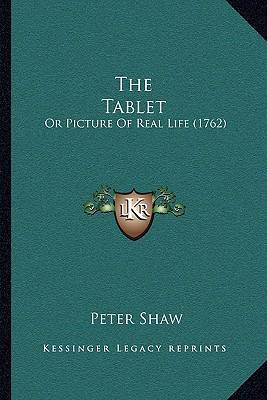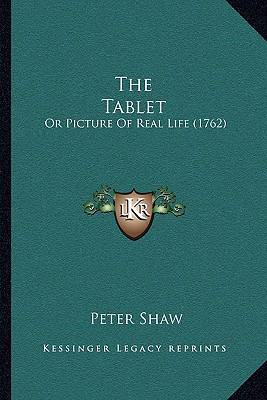
- Afhalen na 1 uur in een winkel met voorraad
- Gratis thuislevering in België vanaf € 30
- Ruim aanbod met 7 miljoen producten
- Afhalen na 1 uur in een winkel met voorraad
- Gratis thuislevering in België vanaf € 30
- Ruim aanbod met 7 miljoen producten
Zoeken
€ 48,95
+ 97 punten
Uitvoering
Omschrijving
The Tablet: Or Picture Of Real Life is a novel written by Peter Shaw and published in 1762. The book is a satirical critique of contemporary society and is divided into four parts. The first part introduces the reader to the protagonist, Mr. Freeman, who is a wealthy merchant. Freeman is portrayed as an honest and virtuous man who is concerned with the moral decay of society. He decides to create a ""tablet"" or a list of virtues that he believes people should aspire to. The second part of the book is a collection of stories that illustrate the virtues on Freeman's tablet. The stories are meant to be cautionary tales and highlight the consequences of immoral behavior. The third part of the book is a critique of contemporary society. Shaw uses satire to expose the hypocrisy and corruption of the upper class. He also criticizes the legal system and the church for their failure to uphold moral values. The final part of the book is a call to action. Shaw urges his readers to strive for virtue and to work towards a better society. He believes that individuals have the power to effect change and that it is their responsibility to do so. Overall, The Tablet: Or Picture Of Real Life is a thought-provoking novel that challenges readers to examine their own values and behavior. It is a timeless work that remains relevant today.This scarce antiquarian book is a facsimile reprint of the old original and may contain some imperfections such as library marks and notations. Because we believe this work is culturally important, we have made it available as part of our commitment for protecting, preserving, and promoting the world's literature in affordable, high quality, modern editions, that are true to their original work.
Specificaties
Betrokkenen
- Auteur(s):
- Uitgeverij:
Inhoud
- Aantal bladzijden:
- 394
- Taal:
- Engels
Eigenschappen
- Productcode (EAN):
- 9781166194246
- Verschijningsdatum:
- 10/09/2010
- Uitvoering:
- Paperback
- Formaat:
- Trade paperback (VS)
- Afmetingen:
- 152 mm x 229 mm
- Gewicht:
- 526 g

Alleen bij Standaard Boekhandel
+ 97 punten op je klantenkaart van Standaard Boekhandel
Beoordelingen
We publiceren alleen reviews die voldoen aan de voorwaarden voor reviews. Bekijk onze voorwaarden voor reviews.











